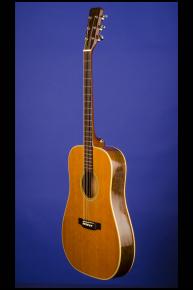One-Of-A-Kind ca. 1965 Martin D-28 'Thinline' Prototype
1965 Martin D-28 14-Fret 'Thin' Prototype
This is a one-of-kind 'Prototype' D-28 built at the Martin factory ca. 1965 at the behest of Don Thompson and John Huber, with Thompson being the head of R&D and Huber having done most of the actual building back then. This unique guitar weighs just 4.20 lbs. and features a laminated, slightly-arched, two-piece, book-matched, Brazilian Rosewood back (with no bracing) and solid Brazilian Rosewood sides. The body measurements are standard D-28 (20 inches in length, 15 5/8 inches wide, 11 1/2 inches wide at the shoulders) BUT with a super thin 2 5/8 - 2 3/4 inch depth. The total neck and body length is 40 5/8 inches as compared to 40 1/4 on a standard D-28. Natural Solid Eastern Mountain 'Close-Grain' 'X-Braced' Spruce top with a four-inch diameter '5-9-5' rosette sound-hole and no pickguard. The top of the body has six-ply black and white binding and the bottom of the body has three-ply black and white binding. The lower-end of the body has a slightly tapering half-inch-wide white strip with two black lines. D-21 style British Honduran Mahogany neck with 'T bar' reinforcement and no 'decorative diamond, or volute'. The nut width is just under under 1 11/16 inches, the scale length is 25.60 inches (as compared to a standard D-28 scale length of 25.40 inches) and the neck profile is thin-to-medium, rising from 0.73 inches behind the 1st fret ; 0.80 inches behind the 7th fret; 0.91 inches behind the 9th fret and 1.10 inches behind the 12th fret. Brazilian rosewood fretboard with ivory nut and 20 original medium frets and no position or side-dot markers. Brazilian Rosewood veneer faced headstock with gold with black trim decal "Martin & Co. / Est. 1833". Original individual Grover Roto-Matic "Pat. Pend. U.S.A." tuners with bell-shaped metal buttons. Black plastic neck-heel laminate. Solid Brazilian Rosewood 'Belly bridge' with ivory drop-in short saddle and 'ivory' Celluloid pins with black dots. Original Piezo transducer under Ivory saddle with connection through endpin. This historically important guitar is in near mint condition with just some very light finish checking to the top and back of the body. Housed in a later Martin four-latch shaped black hardshell case with dark blue plush lining (9.25).
The history of this guitar is that it was made as a one-off prototype and it 'sat around' the Martin factory for several years until the last owner acquired it (from the Martin factory) some thirty-five to forty years ago. The history was related to Matt Umanov, a recognized Martin expert dealer in New York from whom we acquired the guitar.
"Escapees from Martin’s R&D department are rare, especially since that area of Martin barely exists anymore, if at all. This guitar was built in the mid 1960s at the behest of Don Thompson and John Huber, with Thompson being the head of R&D and Huber having done most of the actual building back then. The guitar is essentially a D-28, with all of Martin’s Grade-28 appointments of the day, that has had its body cut laterally, complete with solid spruce top and "CF Martin & Co.” script logo on the peghead, though there is no model number or serial number in the usual place, on the neck block. The sides are of solid Brazilian rosewood and the back is of laminated Brazilian, with no back braces, as none were needed. The neck, which is nice and comfy, has a steel bar in it for strength, almost surely of the “T-bar” type used by Martin since the 1930s; the nut and saddle are of genuine ivory, quite standard back then; the fingerboard and bridge are also Brazilian Rosewood, and the tuning machines genuine American made Grover Rotomatics. This is a most unusual and unique instrument, the likes of which can be found nowhere else and is not likely to reproduced ever again, as those years of Martin’s experimentation, let alone the materials used in this guitar, are long gone. An earlier version of a Piezo transducer is already installed, so you can plug right in and go to town." (Matt Umanov).
"Born in 1940, John Huber studied the guitar, the piano, and the violin as a child. He began his professional career as a guitarist and guitar-maker in earnest in the mid-1960s in Sweden, later apprenticing for several more years with the C.F. Martin Company in Nazareth, Pennsylvania. At present a university-based musicologist in Sweden, Mr. Huber has variously worked for Spanish guitar-makers; American string-makers; German violin and guitar-makers; English violin dealers; has played guitar; and has not only sold violins but has written scholarly books about them. He and his wife live in Stockholm." (Huber. The Development of the Modern Guitar - Guitar Study Series Volume Two).












